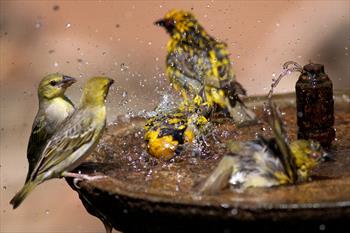Bird bath outdoor

Photo courtesy of Depositphotos
Bathing with water allows birds to have healthy feathers and skin. Wild birds use rainfall, a puddle, lakes, or wet vegetation. Most birds, domestic or wild, spend a lot of time taking care of their feathers. That time is not only normal, but also important. It's easier to loosen dirt on wet feathers and make feathers easier to preen. Birds preen when they arrange their feathers and in doing so spread oil from the preen gland so the feathers remain waterproof and keep them warm by trapping air. Well preened and maintained feathers are also important for aerodynamic efficiency and effective social communication.
New feathers come in, generally speaking, once a year. During that year, the bird needs to keep them in good shape. Many things adversely affect their feathers, such as mites, bacteria and gradual wear so that eventually the feathers are a bit frayed. Keeping good care of feathers likely helps birds fly better.
Most indoor birds enjoy a simple bath, and once you have put everything they need into place, they do all the work while you get to watch your bird enjoy themselves. Watching them take a dip is truly entertaining, hence the popularity of bird baths in yards. Many birds like being misted with a water bottle, while some dislike it.
How often a bird should be bathed comes down to the bird’s preference, not yours. It’s helpful to offer a bath once a week, but some birds will like it more often or less than that. Trial and error is the best method to find out what each particular bird prefers.
Bathing in Water
You can encourage your bird to bathe by offering a shallow dish inside the cage or while out socializing with you. You might also try showering with your bird, as there are commercially available perches for the shower. (Be sure to clean up any bird poop left in the tub or enclosure.)
Some birds prefer to bathe under running water, such as in a sink under a faucet.
Misting
Watch your bird’s body language for signals that they do not like being misted. Body language will vary based on the species and individual parrot, but if you notice any attempts to escape or avoid the spray bottle, or growling/vocalizing, please do not force your bird to be misted. There are several other methods of bathing that will promote preening and you bird might enjoy.
Mist your bird lightly in a manner and schedule that is accepted by your bird, and that adds to its daily life and activities. Misting is supposed to be a good thing, not a bad thing! A light misting merely implies superficial dampening of the feathers enough to guide the bird towards more normal preening activity for a short time period.
If your bird is ill, fearful, or has other medical concerns, misting may not be appropriate.
Misting can be combined with time that is shared with your bird out on a training perch. This combines social interaction with feather care, and the combination of these two categories can enhance the lifestyle and welfare of your parrot. The goal is enrichment, welfare and happiness.
Over the Counter Products
Many products are marketed to enhance the appearance of your bird’s feathers or to stop feather-damaging behaviors. Some of these products have ingredients that are far from natural, and some are realistically appropriate for mammals only. Overall, most of these products will not help, do not teach or enrich alternative activities and behaviors, and some can actually cause harm.
In general, we recommend water as your misting agent, and the money that you save by not purchasing some of these commercially offered sprays can be better applied toward toys or other environmental enriching products.
Outdoor Bird Baths
If you keep a bird bath for wildlife, it needs to provide clean water. That means you will need to clean it. Algae is the most common problem. If you see algae, empty the bath. Mix three parts water to one part vinegar and spray it on the algae. This mixture will not harm nearby plants. OR: one part distilled white vinegar to nine parts water. If necessary, use a wire brush to scrub debris.
If bleach is needed, it should be diluted at about one cup per gallon and used for scrubbing and cleaning. Afterwards, the surfaces should be rinsed well, and allowed to fully air dry before being used.